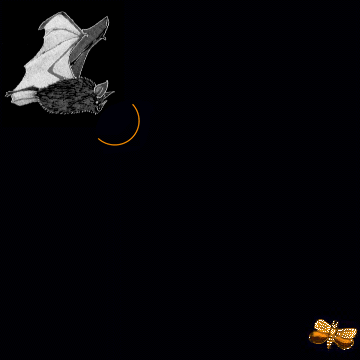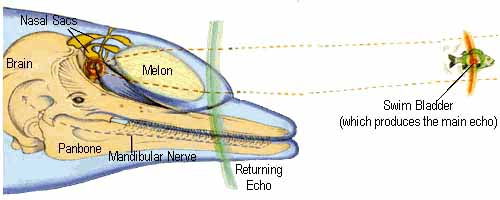Echolocation : Communication of Marine Mammals, Bats, and Humans

Equivalent to sonar or radar, echolocation is the production of sound used for communication. Echolocation is the use of ultra-high frequency sounds for navigation and locating prey. Bats and marine mammals are able to use sound to "see". It is the returning echoes that give the animal an "image" of some parts of its environment.
The echoes must be loud enough to return to the animal and short enough so that the echo of the sender returns back to the animal or human before the next one is sent out. Echolocation is used by mammals like dolphins, whales and bats. Humans have also learned this ability to interact with there environment when they are blind. The term was created by Donald Griffin, who was the first to conclusively demonstrate its existence in bats.

In some bats the sounds are made and sent out by their noses but, most send different sounds through their mouth. The sounds bounce off objects and prey in their surroundings like insects or branches, and are picked up by the bat's sensitive ears. Although bats have good eyesight, they depend on the echolocation system to navigate as well as capture their food. Bats give off pulses at very high frequencies that are not audible to humans, at an impressive rate of 200 pulses per second. They can avoid obstacles no wider than a piece of thread, identify the size of objects, and capture flying insects using this method. There are about 800 different species of bats that use different patterns of frequencies. This allows scientist the ability to identify various types of bats in dark places, such as caves.

Marine mammals also use echolocation as a means of sight. Thought to be an "Auditory Imaging System" by different species of mammals, echolocation involves the vocalizations by the echo locating mammal which detects the echoes of sounds and uses them to produce 3-Dimensional information. For example, dolphins produce sounds by squeezing air through their nasal passages beneath the blowhole. They then focus on sounds they make with their melon. The melon is a fat filled area on the dolphin's forehead that acts like a lens to focus on sound waves ahead of the dolphins. The sound waves given are then reflected off the objects and received through the dolphin's lower jaw.
Echolocation is used to locate prey at great depths when there is very little or no light to see. Whales use a series of clicks during their dives. The depth increases the frequency of the clicks. As the whales approach their prey, the clicks are so close together, they sound like a continuous buzz. The average is approximately 390 meters between the start of the clicking to the 1st buzz.

Scientists have discovered that in the brains of the blind, the visual cortex becomes active when another sense is used or stimulated. The substitutions for sight are typically hearing and touch. With echolocation, blind people can interact with the world like marine mammals and bats. Ben Underwood, a 14 year old of California, is one of the few people who use this method for his "sight". Diagnosed with cancer at the age of 2, he lost his vision and learned to use echolocation as his primary source of navigation. Ben makes "clicking" sounds to communicate with people and to establish the identity of the objects surrounding him. By interpreting the different sound waves reflected off nearby objects, a person trained to navigate by echolocation can identify the location and even the size of nearby objects. They use this information to travel from place to place and steer around obstacles in their course. With echolocation, Mr. Underwood can identify where the curbs are when he is riding his bike around his neighborhood.
